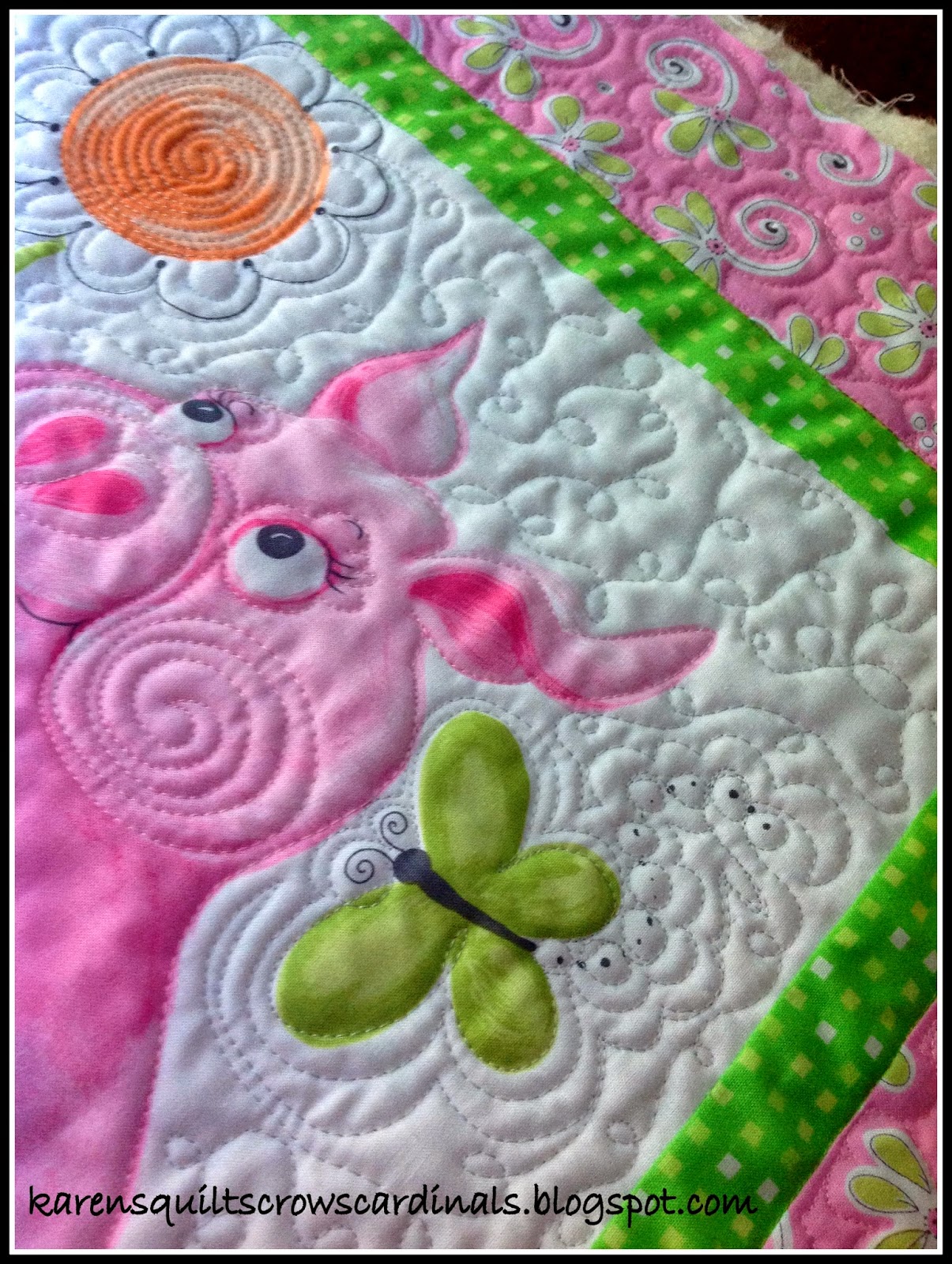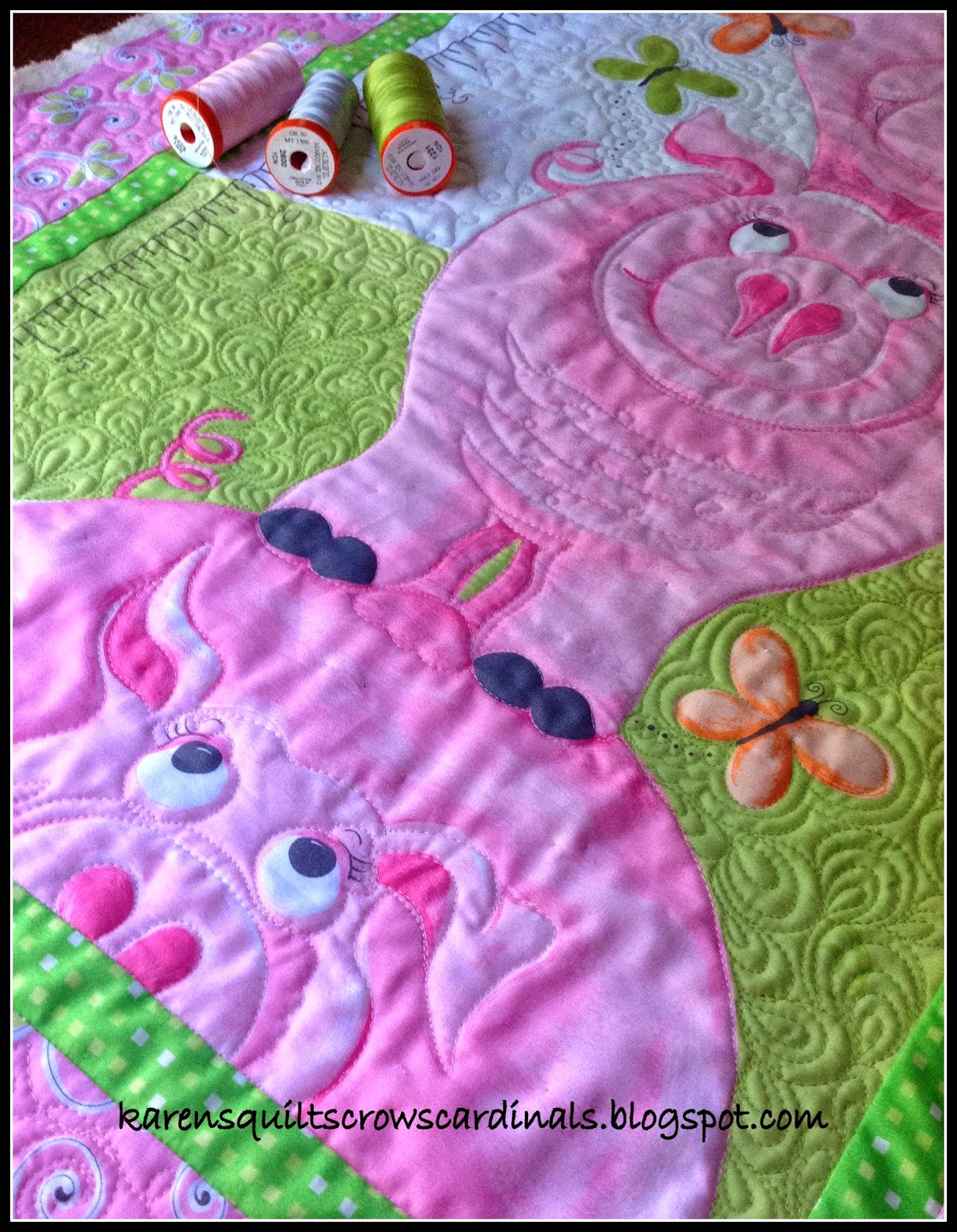It's been many, many weeks since I've had my hand at moving fabric around under a needle - I needed the practice, I needed the down time, I just needed to do it!
This is a sweet little Piggy Growth Chart by The Wonderful
World of Susybee and it's a fun way to get those FMQ juices flowing again. I dove into my stash of beautiful #Aurifil Mako Cotton 50Wt threads and had some fun!!
Here are the steps that worked for me:
1.
Give your machine a good cleaning inside and out. The Janome Horizon doesn't need to be oiled, so a good dusting did the trick. I removed the face plate, swept all around, and discarded those dust bunnies! It's extremely important to start with a clean machine.
2.
Outfit the machine with a Little Genie Magic Bobbin washer -- (see it below in the bobbin area ?) These little guys are the best. They take up that little extra space in your bobbin area and help your bobbin thread glide smoothly - especially during Free Motion Quilting zigs and zags. One washer lasts years so they are well worth the investment (12 per package). I've never done without one and purchased them originally on recommendation from
Leah Day. Give them a try! Share with your friends!
3.
Start with a full-up bobbin loaded with Aurifil Mako Cotton 50Wt thread. YOU KNOW I love this thread! The 50Wt thread is thin and goes a long way to make your bobbin last and last... I use the same thread in the top and bobbin and it works out wonderfully.
4.
Thread, thread, thread -- was fun to open and use a brand new, full spool of
Aurifil thread on the machine. This is Mako Cotton 50 Wt in Color #2423. Just right for the piggy and the border...
5.
Feed Dogs -- to Drop or Not to Drop:
Oh NO! Now all my secrets are out... this is a sweet little workaround to avoid dropping the feed dogs and setting the thread length to zero.
On the Horizon I find that the machine makes more consistent stitches when I leave the feed dogs UP and the thread length at 2.5. (Yet another tip from the wonderfully skilled Leah Day).
I tape this little helper down so that my feed dogs don't damage the underside of the Supreme Slider... PS - I do NOT engage my single hole throat plate on the Horizon as I have a small burr on the underside and it snags and breaks my thread -- I really should have that checked out ;)
NOTE: I've replace my cardboard feed dog cover with one made from template plastic. The template plastic holds up better to the feed dog movement and puts less "dust" into the casing area.
6.
Insert a new needle -- This time I was running with a Microtex 80/12 needle. The Microtex Sharps are fantastic too! Aurifil recommends you use Microtex 80/12 with 50Wt thread - (I didn't realize that). You can see their recommendations for Mako Cotton 50Wt by
clicking here.
Note: My Janome Horizon 7700 REALLY likes it when I use Janome brand needles. Superior Brand Sewing Needles are awesome too!. If you're skipping stitches chances are your needle need to be changed and/or "right sized" or your foot needs to rest closer to the fabric.
7.
Supreme Slider & Gloves: I washed the linty back-side of my Queen Supreme Slider (so it will stick well) and gathered my Machiners X-small gloves. The slider is a Teflon like sheet that allows your quilt to move smoothly over the machine bed. There are other less expensive models available as well but I've not yet tried them. The Gloves are prefect to Grip your quilt layers while manipulating for quilting. The Machingers gloves run large -- so the X-small was well large enough for my hands.
8.
Quilting Foot: Choose and attach your favorite FMQ foot. I normally work with my open foot --if I could only find it (Where did it go ??)
Note: When I quilt around applique I almost always use a CLOSED foot. The Open Toe Feet may catch on wool or needle turn applique pieces, especially if you're using a higher loft batting. Personally I also prefer to use a foot that is ROUND. Some feet are square or oblong and personally I find this distracting, especially when I am echo quilting.
9.
Needle down position: Before you start stitching -- engage the "needle down" option if your machine has it. This way, whenever you stop sewing your needle will stop in the "Down" position. This allows you to reposition your hands without the quilt top moving.
10.
Top thread tension: Last but not least, up the top thread tension -- this is a MUST DO for me on the Janome with Cotton fabric, Aurifil Thread, and one or two layers of batting (cotton/wool). Works like a charm every time.
Note: Each machine and quilting style will vary.
Woohoo! We're ready to stitch !!
Note: This quilt was prepared with one layer of warm and natural batting. An additional layer of Wool or Silk batting would give much more texture to the quilting.
First I wanted to outline all the pigs, then follow their inside features as well, eyes, noses, etc.
On this sweet little growth chart my
customer sister told me not to fuss... so I took a few shortcuts.
To start, bring the bobbin thread to the top, take a couple stitches in place and trim threads (do
not do this on a show or juried quilt).
Proceed around the piggy , highlighting the piggy features as best you can.
This top piggy was fun to stitch -- the rounded features of his face and belly screamed spiral!! I was a little wonky starting out but he's still sweet!!
After outlining the piggies and filling in their features, decide on a background filler (and color).
Use the filler to travel from background component to background component.
I chose to use a quick "loop de loop" and it worked out great.
The Aurifil Mako Cotton 50Wt in Color 2600 gave the background a bit of sparkle... Sweet!
While traveling with the background loop de loop I would find myself inching up on a background component (butterfly, bee, etc).
When close enough stitch in the ditch around the item -- then make a few echo stitches to complete the shape. I love the way stitching the pebbles gives the butterfly movement...
The flower component was fun to quilt! Start on the perimeter and work your way to the middle with a swirl -- then split the width of the quilting on your way back out. Be sure to outline the inside and outside of the petals - and echo stitching always makes things look more defined.
The green background spoke of leaves and grass to me -- so I decided to incorporate an Angela Walters design -- I love the way it turned out.
Oh, and that Aurifil Mako Cotton 50 Wt in Color #1231 matched the greenery perfectly!!
I had a tough time deciding what to stitch in the outer border -- so again I let the fabric talk to me and did an outline stitch around the flowers and swirls and pebbles... I think it came out just fine. Do you like it ?
Here is the status as I head to bed -- I think I need to do something with the green border but my
customer sister is telling me not to fuss.
We'll see what tomorrow brings ;)
You can see other Susybee Growth charts I've quilted
here,
here and
here.
***
There are more Free Tutorials and Patterns on my blog - just
click here -- or visit the
My Tutorials tab at the top of this page (or, on a mobile device drop down the line options).
I also share Free Motion Quilting on a Domestic machine on my
YouTube Channel --
Click here!
I would love to hear your feedback - Thanks for stopping by!
*****
For a more in depth Free Motion Quilting tutorial -- please visit the "Free Motion Quilting Fun" post where I share insight to different weight threads and quilting motif. This main tutorial is hosted by the Bear Creek Quilting Company but you can click here for my introductory post.
*****
Linking up to a few of my favorite parties -- check them out on the sidebar and click on over to view the eye candy.
Hugs,
Karen





















.JPG)















